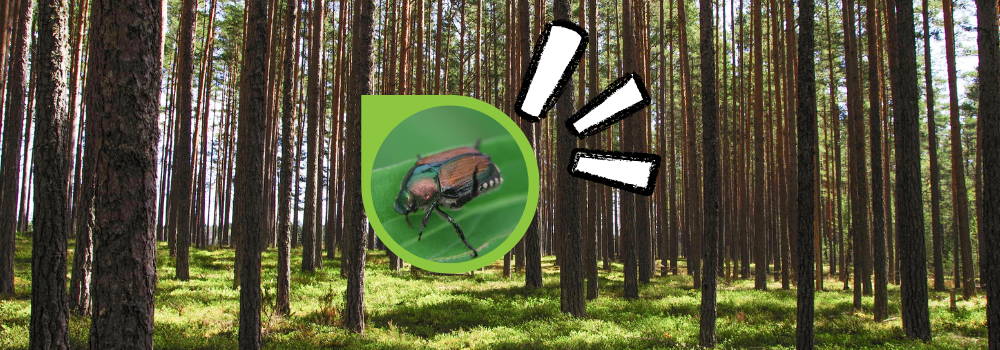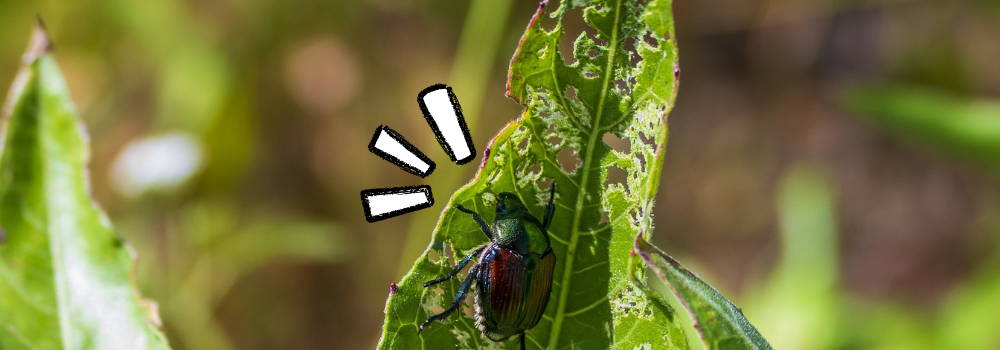Do Japanese Beetles Damage Trees?
Japanese beetles are shiny metallic green beetles that are about half an inch long. It is said that it has accidentally reached the United States back in 1916 through the irises shipped from Japan. Before this, the occurrence of this pest was only known in Japan where it was not considered a major threat to native plants.
These insect pests are metallic green in colour and have bronze wing covers. They lay eggs underground and when hatched, the grubs will start eating organic matter, especially the roots of turfgrasses.
Once it hatches, the eggs will turn into white grubs with C-shaped bodies and orange heads. An adult Japanese beetle will reach its full size of about an inch long as the summer ends.
Summertime is when these pests devastate gardens and lawns. In the South, they emerge from their habitats in mid-June while they appear early in July in the Northern States. The cooler the climate means that they will appear later than usual.
Though they seldom kill shrubs and trees, they can put much stress on the plants and weaken them. This is the reason why they are more vulnerable to secondary pests and diseases. It is estimated that it takes more than $460 million to cover the costs for the damages by these pests and controlling them.
Whether you are dealing with a beetle larvae problem or an adult Japanese beetle infestation, both can make damage to your trees and shrubs. These pests feast on more than 200 plant species. Because they feed in large groups, they leave damages by skeletonizing the foliage.
Any adult beetle feeds on a wide variety of fruits and flowers. Some of their favourite plants are:
Norway Maples
Crab Apples
Roses
Grapes/Grapes Vines
Hibiscus
Pine Oak
Linden
Raspberries
Sassafras
Crape Myrtle
Japanese Maple
Apple
Plum
Cherry
Birch
Currant
Elm
Virginia Creeper
Basil
Marigold
Soybean
Hollyhock
Corn Silks
Though they are known to create damage to many plants and trees, there are still a few trees that these beetles avoid. These trees include:
Red Oak
Red Maple
Evergreens
White Oak
If you have these trees around you and you have learned that your neighbours are having problems with Japanese Beetles, it is less likely for you to experience a heavy infestation of these pests. It is also necessary that you look out for these pests before they can even touch other plants in your lawn or garden.
How Do Japanese Beetles Damage Tree Leaves?
What these pests do is that they wat chunks of tree flowers and leave. Most of the time, they will leave only the skeleton behind.
When the infestation is severe, the leaves may start to turn brown and leaves will start falling prematurely. For larvae that consume the roots of turfgrasses, they eat the roots which kill the grasses. Slowly, the grasses will turn into colour brown and slowly die. You can even pull out the grass easily.
They are considered a serious pest as they can also cause too much damage to vegetables and field crops. This means that if you are trying to grow food that you and your family will consume, you might fail to do so when these pests are present in your lawn.
Damages Caused by Adult Japanese Beetles
Unhealthy or young plants may be injured, stunted, or even die due to persistent and several feeding.
It may affect the appearance of plants.
Though flowering plants like roses can survive these pests, their blossoms might end up getting ruined.
Herbs, fruits, and vegetables can tolerate leaf-feeding but too much may affect the growth and reduce the yield.
Regularly harvesting crops during July and August can reduce the feeding of these pests on the edible parts of the plants.
Damages Caused by Grubs
Grubs chew on grassroots and reduce their ability to take up their required nutrients and water. This prevents the grass from remaining healthy.
When there is severe grub feeding, more dead grass patches will grow.
Due to the lack of roots, these patches can be easily rolled back like a typical carpet.
Only 10 grubs per square foot can be tolerated by healthy turfgrass.
What to Do If Your Lawn or Garden is Infested by Japanese Beetles?
For small infestations, you can handpick the beetles into a bucket of soapy water or any container with soapy water. You should start doing this upon the first sight of these beetles. Remember that the first ones can send out pheromones that will attract more beetles to attack your plants.
You should plant various shrubs, trees, and perennials that will act as a defence barrier to any disease or pest threat. Though defoliated shrubs and trees may not look good, it is recommended that you leave the damage as is.
Defoliation does not kill the plants but causes stress. You can minimize the additional stress by mulching and watering around the plants or trees. Mulching helps in regulating the soil temperature, retaining the moisture, and preventing the mower and whip damages. You can also limit pruning especially when the dormant season is nearby.
Though defoliation may not kill the plants and trees, repeated infestations may worsen the stress. Combining other factors and defoliation, affected plants and trees may slowly begin to decline.
Using Japanese Beetle Traps
These traps work by luring beetles using artificial pheromones. This will attract them to get into the traps and is found highly effective especially in handling small infestations.
However, when placed in a place that is heavily infested, it may worsen the problem as it may attract more beetles. If the beetles do not get into the traps, they will most likely end up feeding on the plants and shrubs around the traps.
Traps can help you determine the severity of the infestation. You can eventually tell how many pests you are dealing with and come up with a more effective solution in getting rid of these beetles.
For traps, we recommend the Rescue Japanese Beetle Trap, Green Earth Japanese Beetle Trap, and the Safers Japanese Beetle Trap. Buy the Safers Japanese Beetle Trap with Safers Japanese Beetle 3 Refill Bags or Safers Japanese Beetle 1 Refill Bait.
Using Insecticides or Pesticides
Most pesticides may only target adult beetles. However, some insecticides can also target the grubs. You just need to carefully read the instructions to know what will work for the adults and the grubs. Also, the labels will help you understand if repeating the treatment is necessary.
Some products that we recommend for dealing with grubs are Botanical Plant & Flower Liq Insect Killer 950ml, POT-It Plant Multi Insect RESIDUAL 400gr, or Scotts Grub B Gon Grub Killer 1.40kg.



